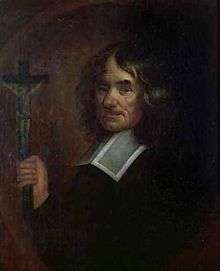John Huddleston

Father John Huddleston (15 April 1608 – buried 13 September 1698) was a monk of the Order of St. Benedict who helped Charles II during his escape and was present when Charles converted to the Catholic faith on his deathbed.
Early life and education
John Huddleston was born at Farington Hall, Lancashire, the second son of Joseph Huddleston from Hutton John, near Penrith in Cumberland. He was educated at the school at Great Blencow nearby, until he was fifteen. When he was twenty he was sent to St Omer's College, and on 17 October 1632, entered the English College in Rome.
Chaplain to Thomas Whitgreave
In 1651 he was staying at Moseley Old Hall, Staffordshire, as chaplain to Thomas Whitgreave's family, prominent local Catholics. After the defeat at the Battle of Worcester on 3 September 1651, Charles II was conducted by Colonel Gifford to Whiteladies Priory on Gifford's Boscobel estate. At Whiteladies, the King was sheltered by the five Penderell brothers who lived there. John Penderell happened to meet Father Huddleston, who suggested that the King should go to Moseley Old Hall on the night of 7 September. Huddleston cleaned and bandaged the King's sore feet. On 9 September, Parliamentary troops questioned Whitgreave, while the King and Huddleston were hiding in the priest-hole. The troops were persuaded that Whitgreave had not fought at Worcester (though he had fought and been captured at the Battle of Naseby in 1645). The troops left without searching the house.
The Benedictines of the Spanish Congregation
Before the King left to meet Jane Lane at Bentley Hall, he promised to look after Huddleston when restored to his throne. Some time after this Huddleston joined the Benedictines of the Spanish Congregation. After the Restoration in 1660, Huddleston was invited to live at Somerset House, London, under the protection of Queen Henrietta Maria. After her death in 1669, he was appointed chaplain to Queen Catherine, with a salary of £100 a year. During the disturbances produced by Titus Oates's pretended revelations, the House of Lords voted on 7 December 1678 that Huddleston, Thomas Whitgreave, the brothers Penderell, and others involved in Charles II's escape should "for their said service live as freely as any of the King's Protestant subjects, without being liable to the penalties of any of the laws relating to Popish recusants".
When Charles II lay dying on the evening of 5 February 1684-5, his brother and heir the Duke of York brought Huddleston to his bedside, saying, "Sire, this good man once saved your life. He now comes to save your soul." Charles declared that he wished to die in the faith and communion of the Holy Roman Catholic Church. Huddleston then heard the King's confession, reconciled him to the Church and absolved him, afterwards administering Extreme Unction and the Viaticum. On the accession of James II, Huddleston continued to stay with the Queen Catherine at Somerset House.
Illness and death
Shortly before his death his mind failed and he was placed in the charge of a trustee. He was buried in the churchyard of St Mary-le-Strand.
Several portraits of Huddleston exist: Houseman's done in 1685 is at Hutton John; another is at Sawston Hall, Cambridgeshire.
References
| Wikisource has original text related to this article: |